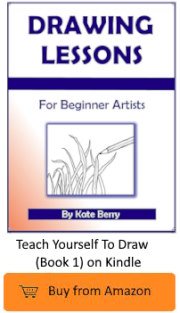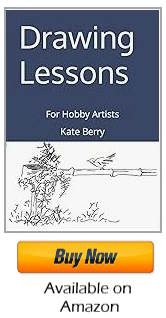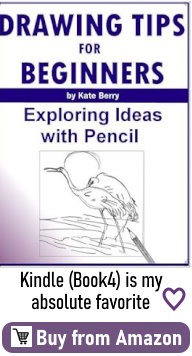Search for images or info
Wildlife Pencil Drawings
The wildlife pencil drawings on this page represent only a small portion of the wildlife that exists today.
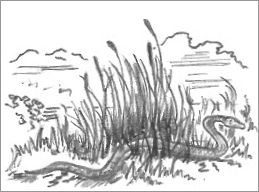
The word wildlife describes animals and plants in their natural state. They exist in forests, national parks or public land.
Wildlife would include bears, birds, rodents, insects, snakes, fish, deer and so on.
I created the drawings of wildlife (below) in my second year as a hobby artist. I was pretty excited that they turned out as well as they did because I still have a long way to go with general learning and practice.
Beside each wildlife drawing you will find out a little bit about each subject to help you understand more as you draw.
Elephant Drawing
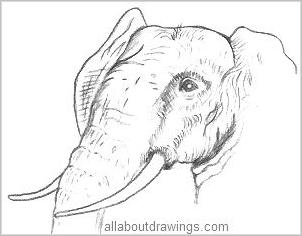
I love to draw elephants even though they are a bit challenging.
This is my favorite out of all the wildlife pencil drawings and that's mainly because I am surprised with the result.
Elephants make a great drawing subject and this particular artwork looks very attractive when framed.
Elephants are the largest land animals with very thick skin.
They live almost as long as people and are fully grown at 20 years of age.
An African elephant has bigger ears than an Indian elephant.
A Leopard Drawing
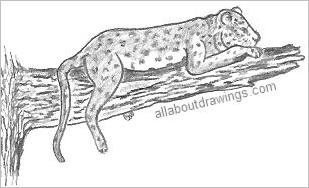
Leopards are wild cats that are smaller than lions.
They are found in Africa and South Asia.
Leopards are spotted like jaguars but leopards have blotchy spots called rosettes which are different to jaguar spots.
Leopards hunt from trees by lying in wait on a branch. This leopard drawing portrays him having a bit of a rest as he waits for his next feed.
Categories
Sketches
Instruction
Freebies
Other Areas
** Disclaimer: I receive a small commission if you buy via my links -- at no extra cost to you. **
The How To Sketch Guide
Here's a book that finally dispels the mystery of sketching!
... it only takes a little instruction
or guidance... Read more >>
Drawing Of A Deer
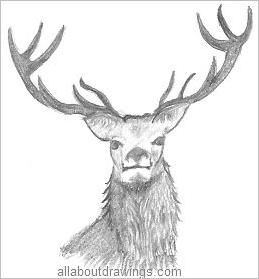
A Royal Stag has six points on its antlers to show he is fully grown.
The male deer grows new antlers every year.
The antlers are covered with a velvet like, hairy skin.
Deer belong to the cow and antelope family.
I wasn't sure about this drawing of a stag, but my Mum liked it and insisted I show you.
The main thing with drawing is to enjoy it, keep an open mind and experiment by trying to illustrate all different subjects.
The antidote to fear is courage so I put on a brave front and draw whatever I see. If you adopt the same attitude, you discover hidden talent that you didn't know you had.
Camel Drawing
A camel's hump doesn't contain water but it is filled with a store of fat. This helps a camel live up to a week without eating or drinking.
Camels have wide splayed feet to help them grip on to loose sandy ground.
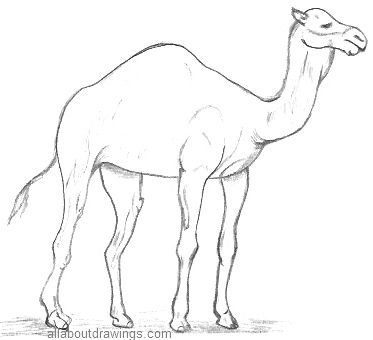
This camel drawing has been left as almost an outline because I liked it just like this. If I don't feel certain about how to create overall effects, I quit while the image looks good enough.
I hope you find it easy to copy when you start creating your own portfolio of wildlife pencil drawings.
A Snake Drawing
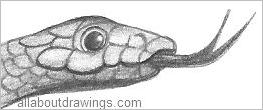
Snakes are reptiles.
They move by slithering or wriggling.
Their skin is dry and smooth.
Most snakes hatch from eggs.
The snake drawing took a little bit of patience but the result is worth the time.
The scope of wildlife pencil drawings is huge and while snakes are not my favorite animal, it was only natural that I include one here.
Drawing the body of a snake was too challenging at this stage so I simplified the task by portraying only the head.
Drawing Of A Rhino
This rhinoceros drawing is done as a simple outline for ease of copying. The shading strokes here and there add great effect towards a finished piece.
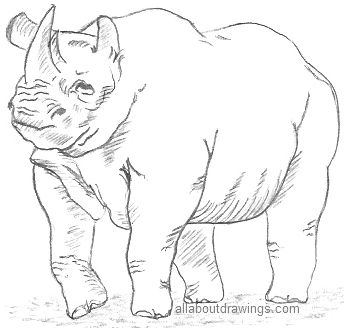
The rhinoceros is one of the largest and strongest of all animals and it can weigh up to 5 tonne. It has a tough, leathery skin and one or two horns on its snout.
Giraffe Drawing
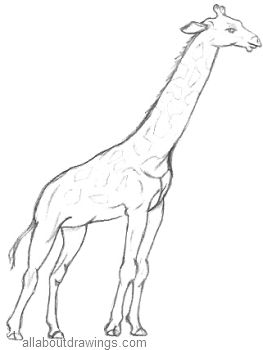
Giraffes are the tallest animals.
They eat shrubs and trees.
When they bend their necks to drink, they spread their front legs wide.
This giraffe drawing was erased a few times but I think I ended up with a reasonable likeness after a fair amount of persistance.
It might help to measure your picture with your pencil and then place marks on your paper to designate height and width.
This little measuring tip helps beginner artists achieve more than what they really think is possible.
A Gorilla Drawing
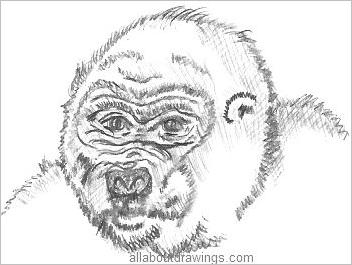
A gorilla's eyes are close set, the nose is flat and the mouth is broad.
Their arms, legs, hands and feet are similar to humans.
The Gorilla is the largest of apes.
They live in family groups and can be found in Central Africa.
You can see the gorilla drawing is done with cross-hatching which was good fun to experiment with.
This drawing is not my best work but after trying to get the head shape correct, I decided this was my best effort to date.
I had to include this fellow with the other wildlife pencil drawings because I feel like he belongs here.
I am eager to do another gorilla drawing because with every drawing I can see an improvement on the last.
Inject Variety Into Your Artwork
Although animals can be very challenging, I was happy I attempted to form these wildlife pencil drawings at an early stage.
With all the practice I now do, it's noticeable when the artistic part of my brain takes over and the peace I feel is very real.
If you're wondering what pencil and paper I use for these illustrations, they are all done with a 2B mechanical pencil on photocopy paper.
There are many more drawings of wildlife yet to explore so you don't need to worry about running out of things to draw. Practice really does make perfect.
I experimented with different methods of sketching in each wildlife drawing. The variety of strokes makes it so much more interesting for me plus it's more challenging. I can't say I've ever been bored with this little hobby.
Click a link below to view various animal illustrations:
* Allaboutdrawings.com is a participant in the Amazon Services LLC Associates Program, an affiliate advertising program designed to provide a means for sites to earn advertising fees by advertising and linking to Amazon.com.
Copyright © 2005 - 2025 www.allaboutdrawings.com. All rights reserved.





